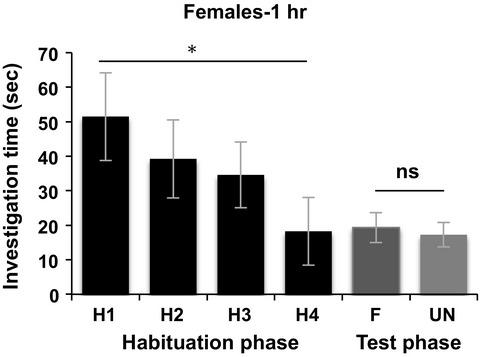Our official English website, www.x-mol.net, welcomes your
feedback! (Note: you will need to create a separate account there.)
Sex differences in olfactory social recognition memory in meadow voles, Microtus pennsylvanicus
Ethology ( IF 1.3 ) Pub Date : 2020-07-20 , DOI: 10.1111/eth.13074 Kelsey E. Clark 1 , Kaitlynn A. Messler 1, 2 , Michael H. Ferkin 1
Ethology ( IF 1.3 ) Pub Date : 2020-07-20 , DOI: 10.1111/eth.13074 Kelsey E. Clark 1 , Kaitlynn A. Messler 1, 2 , Michael H. Ferkin 1
Affiliation

|
Terrestrial mammals, like rodents, use odors, and scent marks to indicate their presence in an area to conspecifics. These odors convey information about the scent donor's genotype, sex, condition, and age. The ability to discriminate among the scent marks of conspecifics and later recollect the identity of the donor is essential for choosing between familiar and unfamiliar mates. We tested the hypothesis that the promiscuous meadow vole (Microtus pennsylvanicus) can recollect the odor of a familiar, opposite‐sex conspecific and distinguish it from that of an unfamiliar, opposite‐sex conspecific. We also hypothesized that because reproductive success is highly skewed among male meadow voles and competition for mates is intense, males will be more likely than females to recollect the odor of a familiar, opposite‐sex conspecific and distinguish it from that of an unfamiliar, opposite‐sex conspecific, for a longer period of time. Using a habituation task, we first exposed the voles, 4 times successively, to the anogenital area scent of an opposite‐sex conspecific. Then, 1 hr, 24 hrs, 72 hrs, or 96 hrs after the fourth exposure, voles were presented with the odor of the donor from the exposure phase (familiar donor) and that of an unfamiliar, opposite‐sex conspecific. Female meadow voles spent similar amounts of time investigating the scent of the familiar male donor and that of an unfamiliar male donor after the 1‐hr and 24‐hr intervals. Male meadow voles, however, spent more time with the scent of an unfamiliar female donor than that of the familiar female donor after the 1‐hr, 24‐hr, and 72‐hr intervals, suggesting that male voles could recollect the scent mark of a familiar female for at least three days. The implications of these sex differences in social memory may reflect the different strategies male and female meadow voles use in the recognition of previous and potential mates. Recognition of an individual's scents may enhance fitness by allowing animals to direct appropriate behaviors toward those individuals.
中文翻译:

草地田鼠嗅觉社会认知记忆的性别差异
陆生哺乳动物(例如啮齿动物)会使用气味和气味标记来指示它们在特定区域内的存在。这些气味传达了有关香味供体的基因型,性别,状况和年龄的信息。区分同种异味的气味标记,并在以后重新收集供体身份的能力对于在熟悉和不熟悉的同伴之间进行选择至关重要。我们检验了杂草草甸田鼠(Microtus pennsylvanicus)可以重新收集熟悉的异性同性伴侣的气味,并将其与陌生的异性同性伴侣的气味区分开。我们还假设,由于雄性草地田鼠的生殖成功高度偏向,并且对伴侣的竞争非常激烈,因此雄性比雌性更有可能重拾雌性,异性同种的异味,并将其与陌生,异性的异种区别开来。性别特定,时间更长。使用适应性任务,我们首先将田鼠连续4次暴露于异性同种异体的肛门生殖器区域。然后,在第四次暴露后1小时,24小时,72小时或96小时,田鼠出现了暴露期的供体气味(熟悉的供体)和陌生的异性同种异味。在1小时和24小时的间隔后,雌性草地田鼠花费了相似的时间来调查熟悉的男性供体和不熟悉的男性供体的气味。然而,雄性草地田鼠在1小时,24小时和72小时的间隔后,花在陌生雌性供体身上的时间比熟悉的雌性供体上花费的时间更多,这表明雄性田鼠可以重新收集雌性田鼠的气味标记。熟悉的女性至少三天。这些性别差异对社会记忆的影响可能反映了男性和女性草地田鼠在识别先前和潜在配偶时采用的不同策略。对个体气味的识别可以通过允许动物对这些个体进行适当的举止来增强其适应性。
更新日期:2020-07-20
中文翻译:

草地田鼠嗅觉社会认知记忆的性别差异
陆生哺乳动物(例如啮齿动物)会使用气味和气味标记来指示它们在特定区域内的存在。这些气味传达了有关香味供体的基因型,性别,状况和年龄的信息。区分同种异味的气味标记,并在以后重新收集供体身份的能力对于在熟悉和不熟悉的同伴之间进行选择至关重要。我们检验了杂草草甸田鼠(Microtus pennsylvanicus)可以重新收集熟悉的异性同性伴侣的气味,并将其与陌生的异性同性伴侣的气味区分开。我们还假设,由于雄性草地田鼠的生殖成功高度偏向,并且对伴侣的竞争非常激烈,因此雄性比雌性更有可能重拾雌性,异性同种的异味,并将其与陌生,异性的异种区别开来。性别特定,时间更长。使用适应性任务,我们首先将田鼠连续4次暴露于异性同种异体的肛门生殖器区域。然后,在第四次暴露后1小时,24小时,72小时或96小时,田鼠出现了暴露期的供体气味(熟悉的供体)和陌生的异性同种异味。在1小时和24小时的间隔后,雌性草地田鼠花费了相似的时间来调查熟悉的男性供体和不熟悉的男性供体的气味。然而,雄性草地田鼠在1小时,24小时和72小时的间隔后,花在陌生雌性供体身上的时间比熟悉的雌性供体上花费的时间更多,这表明雄性田鼠可以重新收集雌性田鼠的气味标记。熟悉的女性至少三天。这些性别差异对社会记忆的影响可能反映了男性和女性草地田鼠在识别先前和潜在配偶时采用的不同策略。对个体气味的识别可以通过允许动物对这些个体进行适当的举止来增强其适应性。











































 京公网安备 11010802027423号
京公网安备 11010802027423号